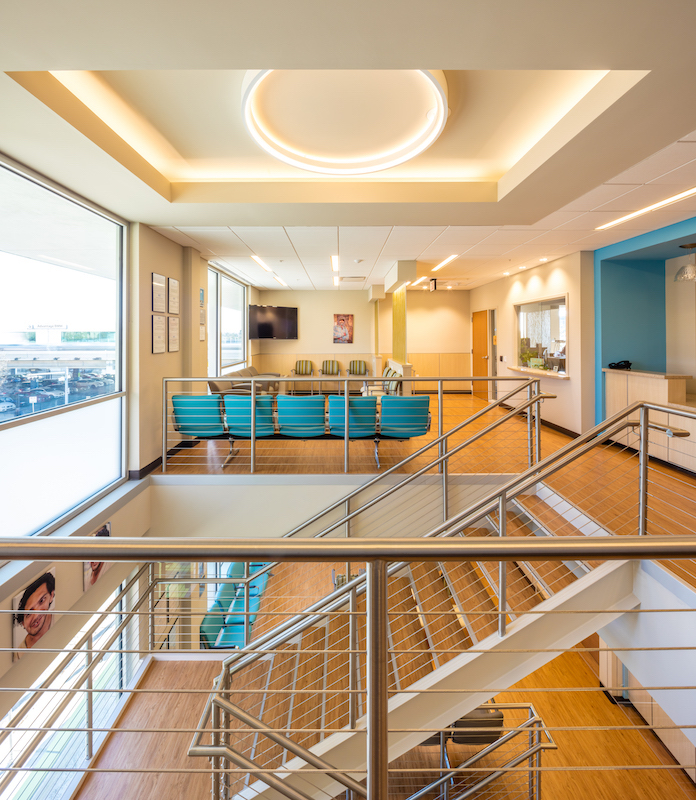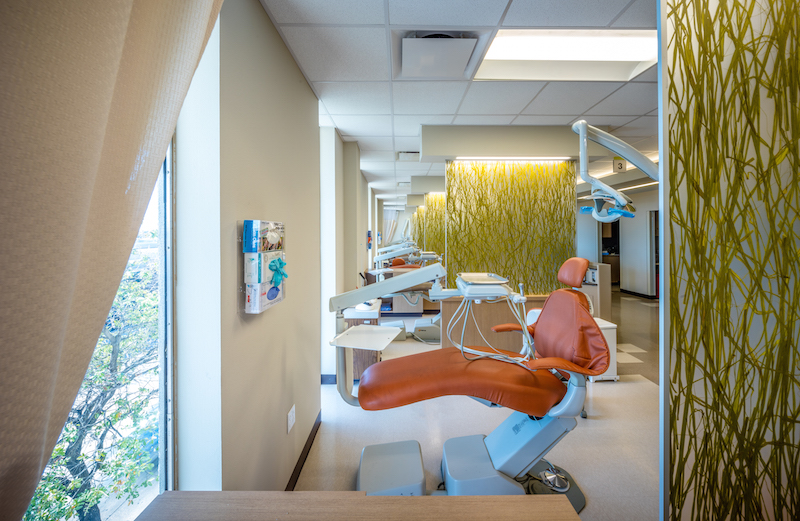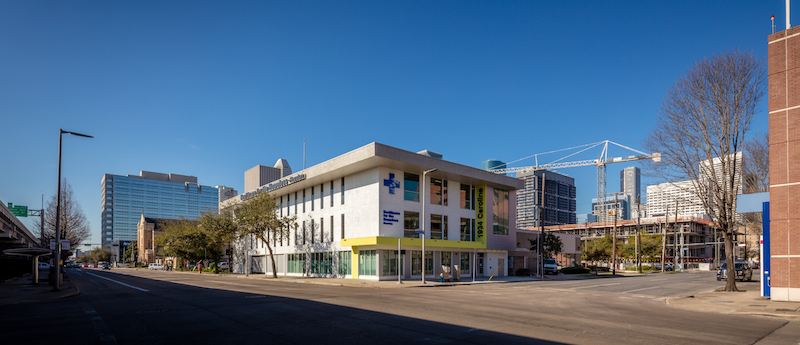In 2012, the architectural firm Page Southerland Page did pro bono programming work for Healthcare for the Homeless Houston (HHH), a nonprofit organization that provides long-term care for that city’s homeless men, women, and children.
At the time, HHH—which was founded in 1999 and is part of a national organization with more than 150 health centers—was operating out of a shoebox, a 6,425-sf building it shared with another homeless services group. The programming was conducted with an eye toward assisting HHH in its strategy to relocate and expand.
“They knew they had to leave that building,” recalls Kurt Neubek, FAIA, Principal with Page’s Houston office.
The organization found a three-story, 24,250-sf building that had been a Merchant Marine hall known as the Seafarer’s Union, which HHH selected in part for its proximity to St. Joseph Hospital, which handles many homeless patients.
“Our goal was to design the clinic around our clinical model,” which is the integration of primary care, behavioral care, and consultation and case management services, explains Frances Isbell, M.A., HHH’s chief executive officer. “We also didn’t want it to look like a bus station.”
Last February, HHH celebrated its first anniversary in its new, larger digs, whose extensive renovation presented a number of challenges to a Building Team that included Page (architect and MEP engineer), WSP (co-consultant), ASA Daily (SE), H2B Engineers (CE), Forney Construction (CE), FMG Design (signage and graphics), and TechKnowledge (A/V, IT, Security).
For one thing, each floorplate is only 8,000 sf. Half of the first floor was taken up by indoor parking. And the third floor was a giant open meeting room.
The first thing that Page did, says Neubek, was to move the front door to the short side of the building, partly to dissuade the homeless from congregating at a nearby restaurant. Page also relocated the parking garage to the back of the first floor, which freed up a bit more administrative space.
The second floor includes the main reception desk and the medical clinic with 12 exam rooms, an in-house pharmacy, and small testing labs. The design of this floor is a flexible module so offices can be converted to exam rooms if needed, and vice versa.
The third floor has six dental stations—dental care being HHH’s most sought-after service, says Isbell—and behavioral health spaces and offices with glass sidelights that allow more daylight to come onto the floor. The third floor includes workstations, training areas, and lockers for HHH’s 400 annual volunteers.

A “grand staircase” between waiting rooms ties together the floors of this facility. Vinyl plank flooring was selected for its durability and sense of warmth. Image: Slyworks Photography/Courtesy of Page.
Before construction, exam rooms were mocked up to allow physicians and attending staff to determine if counter and cabinet heights and spaces between equipment were positioned properly. Patient rooms were also oriented toward the back of the building, which provides the staff with a higher measure of safety in the event that patient behavior becomes problematic.
Other design accommodations include an open staircase between waiting areas that ties the floors together, more exterior coverage over the reclad entryway with a new exterior lantern, a new elevator, and larger energy efficiency windows. The second floor clinic offers patients electrical outlets where they can recharge the mobile devices. Translucent partitions between the dental stations and waiting rooms offer privacy while still letting light permeate the building.
One of the more noticeable features of the new building is its flooring. Isbell says that it had to be durable, “as people living on the street are bringing all of their worldly possessions in with them.” HHH also wanted the interior design to provide a sense of warmth. So 2,232 sf of the second and third floors and stairwell are covered with Parterre’s ingrained natural oak luxury vinyl planks.

Dental care is the most sought-after service at Healthcare for the Homeless Houston's new facility, which has six dental stations bookended by translucent partitions. Image: Slyworks Photography/Courtesy of Page.
The whole project cost about $8.5 million, which HHH financed through a combination of state and private foundation grants. Neubek says TechKnowledge donated all of its services, and most of the ceiling tile and lighting used for the renovation were donated, too.
Isbell says that moving into the new center is a benchmark for this organization, which operates two other facilities in Houston. Most important, it allows the organization to see more patients daily. (The three centers average about 100 per day.) But, she laughs, “if it ever happens again, I’ll retire. It was a lot of work.”
Related Stories
Healthcare Facilities | Jun 5, 2023
Modernizing mental health care in emergency departments: Improving patient outcomes
In today’s mental health crisis, there is a widespread shortage of beds to handle certain populations. Patients may languish in the ED for hours or days before they can be linked to an appropriate inpatient program.
Healthcare Facilities | Jun 1, 2023
High-rise cancer center delivers new model for oncology care
Atlanta’s 17-story Winship Cancer Institute at Emory Midtown features two-story communities that organize cancer care into one-stop destinations. Designed by Skidmore, Owings & Merrill (SOM) and May Architecture, the facility includes comprehensive oncology facilities—including inpatient beds, surgical capacity, infusion treatment, outpatient clinics, diagnostic imaging, linear accelerators, and areas for wellness, rehabilitation, and clinical research.
Healthcare Facilities | May 19, 2023
A new behavioral health facility in California targets net zero energy
Shortly before Mental Health Awareness Month in May, development and construction firm Skanska announced the topping out of California’s first behavioral health facility—and the largest in the nation—to target net zero energy. Located in Redwood City, San Mateo County, Calif., the 77,610-sf Cordilleras Health System Replacement Project is slated for completion in late 2024.
3D Printing | May 12, 2023
World’s first 3D-printed medical center completed
3D construction printing reached new heights this week as the world’s first 3D-printed medical center was completed in Thailand.
Sustainability | May 11, 2023
Let's build toward a circular economy
Eric Corey Freed, Director of Sustainability, CannonDesign, discusses the values of well-designed, regenerative buildings.
Digital Twin | May 8, 2023
What AEC professionals should know about digital twins
A growing number of AEC firms and building owners are finding value in implementing digital twins to unify design, construction, and operational data.
Design Innovation Report | Apr 27, 2023
BD+C's 2023 Design Innovation Report
Building Design+Construction’s Design Innovation Report presents projects, spaces, and initiatives—and the AEC professionals behind them—that push the boundaries of building design. This year, we feature four novel projects and one building science innovation.
Sustainability | Apr 20, 2023
13 trends, technologies, and strategies to expect in 2023
Biophilic design, microgrids, and decarbonization—these are three of the trends, technologies, and strategies IMEG’s market and service leaders believe are poised to have a growing impact on the built environment.
Design Innovation Report | Apr 19, 2023
HDR uses artificial intelligence tools to help design a vital health clinic in India
Architects from HDR worked pro bono with iKure, a technology-centric healthcare provider, to build a healthcare clinic in rural India.
Healthcare Facilities | Apr 17, 2023
UC Irvine takes sustainability to new level with all-electric medical center
The University of California at Irvine (UCI) has a track record for sustainability. Its under-construction UCI Medical Center is designed, positioned, and built to preserve the nearby San Joaquin Marsh Reserve, to reduce the facility’s solar gain by 85%, and to be the first medical center in the country to operate on an all-electric central plant.

















